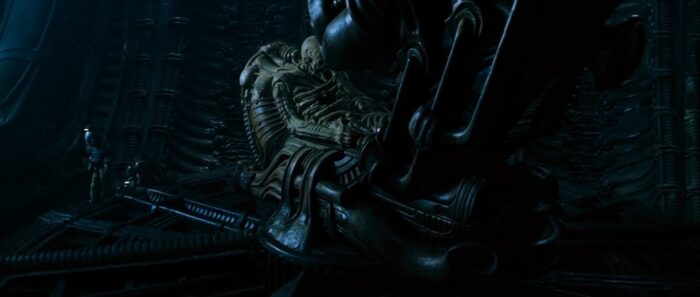“Lovecraftian Horror” or the broader label of “Cosmic Horror” is a subgenre of horror and science fiction that traces back primarily to author Howard Philips Lovecraft. Lovecraft is its most famous originator and his stories offer examples of the genre in its most distilled form. Perhaps this quote from Lovecraft’s “The Picture in the House” best sums up his signature mood:
Just what it was I feared or loathed, I could by no means define; but something in the atmosphere seemed redolent of unhallowed age, of unpleasant crudeness, and of secrets which should be forgotten.”
There are plenty of things to be afraid of here: old power, old knowledge, the unknown, mankind’s helplessness before it all, and existential threats to one’s existence or of their preconceptions of nature and its rules. The context for this is important: Lovecraft was a pathetically racist and fearful man. His stories of local populations making deals with terrifying unknown beings read as a diatribe against immigration and multiculturalism. Alan Moore described him as a “barometer of American dread” in the early twentieth century, whose fears were “precisely those of the white, middle-class, heterosexual, Protestant-descended males who were most threatened by the shifting power relationships and values of the modern world.”
So, Lovecraft’s stories can be read as a projection of existential angst against the growing tides of immigration, multiculturalism, and globalization. In “The Shadow Over Innsmouth,” it is the town of Innsmouth, Massachusetts and the cult members residing there who offer sacrifice to and eventually breed with a sea-born race known as the “deep ones,” producing offspring that resemble humans before eventually transforming later in life into something resembling the deep ones themselves. In the story, this tradition even comes over from a tribe of Pacific Islanders visited by a character named Marsh. This is perhaps one of the least subtle manifestations of Lovecraft’s racism. It’s very obvious that the deep ones are a stand-in for any non-WASP race of people from across the ocean, their hybrid offspring revealing Lovecraft’s opinion on mixed-race peoples.
This distasteful metaphor might make the story a bit difficult to approach, and is at least in part why we haven’t seen many direct adaptations of “The Shadow Over Innsmouth” on film. Dan Gildark’s Cthulhu does something interesting with the story, however, by turning the metaphor on its head. In Cthulhu, main character Russ (Jason Cottle) is a gay academic who reunites with his family after his mother’s death, including his father (Dennis Kleinsmith), who leads a cult like the one in the original story. The film is less about immigration and race as it is about the alienation gay people often feel from the closed-minded community of their upbringing. Even if the film itself is not very compelling, it is a clever reimagining of the original story’s themes and concepts. The feeling of powerlessness and fear before an uncaring greater power makes a lot more sense from the perspective of a marginalized community than that of an aggrieved white man. It’s a clever way of using one of Lovecraft’s own stories to rewrite and reclaim his more sordid legacy.

Elsewhere, more direct adaptations of Lovecraft stories often fall flat. Re-animator is probably the most famous direct adaptation of his stories, with an 80s-set take on “Herbert West: Reanimator,” although it is a markedly less ambitious and more obviously palatable concept than most of his other work. There is also the Roger Corman-produced The Dunwich Horror, from the story of the same name, also relatively well-regarded but decidedly less ambitious than his more famous stories. Filmmakers have tried to adapt such cosmically-minded stories like, for instance, The Color Out of Space many times, most recently by director Richard Stanley and star Nic Cage, to middling results. Perhaps Guillermo Del Toro might have had some success if he had been able to make his At The Mountains Of Madness.

Filmmakers have also long taken indirect inspiration from Lovecraft to spin their own stories of the unknown. There is, of course, John Carpenter’s The Thing, in which the horror is both from the insanity that the monster itself unleashes, but also the creature’s ability to blend in and imitate the human characters. The Thing evokes Lovecraft in its confidence that there is horror in the unknown and unexplainable, and in its emphasis on the psychological effects that the horrors have on its characters. Carpenter also channeled Lovecraft with In the Mouth of Madness, but that film seems less interested in adapting elements of Lovecraft as it is in paying homage. Steven Kostanski and Jeremy Gillespie’s The Void mashes together a number of concepts from Lovecraft and Lovecraftian horror, invoking stories like Herbert West: Re-animator and the aforementioned Shadow Over Innsmouth. The film does an interesting job portraying the kind of abstract horror of resurrection and the titular “void,” and creates some appropriately grizzly monsters, even if it does mostly come across as a low-rent version of Assault On Precinct 13. The Void also leverages disappointingly tired tropes of grief, loss, and trauma that the horror genre as of late has arguably trivialized into stock emotions and story beats.

Maybe the most famous film with Lovecraft’s influence all over it is the original Alien. Dan O’Bannon, writer and visual designer on Alien, once said that Lovecraft’s stories “aren’t just there to inspire fear or loathing; those are the side dressing [for] the sense of cosmic amazement that Lovecraft had…fear of god, not that [he] believed in god.” The sequence in the original Alien planet LV-426 sees a number of unexplainable things that provide questions without answers and fear of old, powerful beings, with the derelict ship and the mysterious alien corpse. Similarly, Lovecraft’s “At The Mountains of Madness” details an expedition into Antarctica that discovers a lost civilization of beings known as “elder ones,” who lived on earth and created artificial life forms known as Shoggoths to do tasks for them, before they eventually turned on the elder ones and destroyed them. Prometheus and its follow-up Alien: Covenant incorporate elements of this story with the Engineers, forerunners of humanity, and the black goo they had created as a bioweapon, but which they eventually lost control of and were wiped out by on the planet in which Prometheus takes place.
I personally always like to point to Danny Boyle’s Sunshine as perhaps the strongest translation of Lovecraft’s ideas on film. It is appropriate that a story about mankind trying to challenge the course of nature by dropping a bomb into the sun might evoke some sense of the “cosmic amazement” that Dan O’Bannon describes. The very first scene in the film shows the spacecraft Icarus 2’s psychological officer Searle (Cliff Curtis) in a room that allows him to observe the sun at various brightness levels. He is transfixed by our star’s brilliance, almost hypnotized by it.
In the climax, the remaining crew of Icarus 2 is chased around their ship by the mad captain of the Icarus 1 expedition. The captain of the previous expedition Pinbacker (Mark Strong) is seen earlier in the film in a video log saying that “it is not our place to challenge god,” and it is established that he sabotaged the original Icarus 1 mission to the sun. After he boards the Icarus 2 craft and starts trying to kill everyone on board, he eventually pursues the two surviving crew members into the payload itself, the large bomb that the crew was sent to launch into the sun (It’s best not to ask about the actual science behind Sunshine). During this sequence, as the crew gets exceedingly close to the sun’s atmosphere, the film freezes and skips during this sequence as if reality itself is malfunctioning, warping and bending around them. The sun is not a place humans were meant to approach, and the way it affects Sunshine’s characters and the film itself suggests an almost sinister nature. It’s as if the sun is fighting back against the crew and their mission, a wailing god on its last legs.
Like a good Lovecraft story, though, we’re not given any real insight into the nature of the sun, only its effect on people like Captain Pinbacker. Yet, its power is felt, and it is this suggestion of its power beyond just what we know to be true that is most terrifying to simply think about. It’s something we don’t fully understand, and can’t ever hope to. It’s this fear, in spite of its origins, that makes Lovecraft so influential.

Filmmakers in the modern day have had relatively little success translating Lovecraft’s themes when they stick so close to his original stories. There are certainly clever takes on Lovecraft like the aforementioned Cthulhu, which still mostly fails to adequately portray the horror that it aspires to. The greatest reflections of Lovecraftian horror are those that take his ideas and extrapolate them into something original. It is, in a way, a liberating experience to see something like Cthulhu or the novel “Lovecraft Country” that translate the author’s intent to reckon with the experience of groups like LGBT people and Black Americans. Though Lovecraft’s ideas and concepts were based in bigotry, his sense of fear, that of powerlessness and the indifference of nature, is universal.



